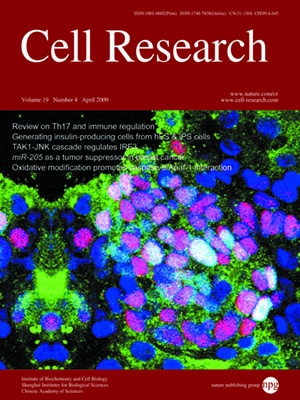
Volume 19, No 4, Apr 2009
ISSN: 1001-0602
EISSN: 1748-7838 2018
impact factor 17.848*
(Clarivate Analytics, 2019)
Volume 19 Issue 4, April 2009: 429-438
ORIGINAL ARTICLES
Highly efficient differentiation of human ES cells and iPS cells into mature pancreatic insulin-producing cells
Donghui Zhang1,2,*, Wei Jiang1,*, Meng Liu1,2, Xin Sui1,2, Xiaolei Yin1,2, Song Chen1, Yan Shi2 and Hongkui Deng1,2
1Key Laboratory of Cell Proliferation and Differentiation of the Ministry of Education, College of Life Sciences, Peking University, Beijing 100871, China
2Laboratory of Chemical Genomics, Shenzhen Graduate School of Peking University, Shenzhen 518055, China
Correspondence: Donghui Zhang,(hongkui_deng@pku.edu.)
Human pluripotent stem cells represent a potentially unlimited source of functional pancreatic endocrine lineage cells. Here we report a highly efficient approach to induce human embryonic stem (ES) cells and induced pluripotent stem (iPS) cells to differentiate into mature insulin-producing cells in a chemical-defined culture system. The differentiated human ES cells obtained by this approach comprised nearly 25% insulin-positive cells as assayed by flow cytometry analysis, which released insulin/C-peptide in response to glucose stimuli in a manner comparable to that of adult human islets. Most of these insulin-producing cells co-expressed mature β cell-specific markers such as NKX6-1 and PDX1, indicating a similar gene expression pattern to adult islet β cells in vivo. In this study, we also demonstrated that EGF facilitates the expansion of PDX1-positive pancreatic progenitors. Moreover, our protocol also succeeded in efficiently inducing human iPS cells to differentiate into insulin-producing cells. Therefore, this work not only provides a new model to study the mechanism of human pancreatic specialization and maturation in vitro, but also enhances the possibility of utilizing patient-specific iPS cells for the treatment of diabetes.
Cell Research (2009) 19:429-438. doi: 10.1038/cr.2009.28; published online 3 March 2009
FULL TEXT | PDF
Browse 1835


